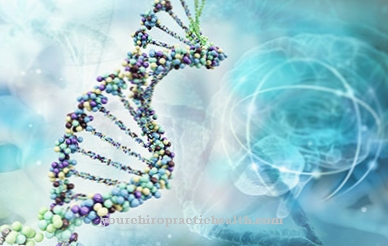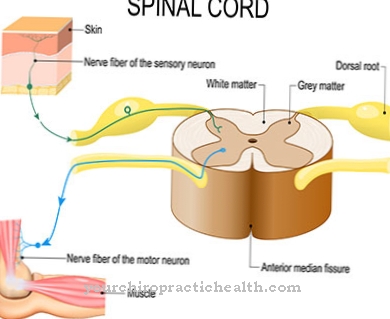The Waterhouse-Friderichsen Syndrome is a relatively infrequent disease, but represents an enormous risk to the life of the person affected. For this reason, it is extremely important that - after the diagnosis - immediate intensive medical treatment is carried out.
What is Waterhouse-Friderichsen Syndrome?
The medic describes as Waterhouse-Friderichsen Syndrome a state of shock caused by bacterial toxins, which is primarily caused directly by the bacteria. Subsequently, there is an enormous consumption of coagulation factors (so-called consumption coagulopathy), so that parts of the tissue (hemorrhagic necrosis) of the adrenal cortex die off.
The death causes bacterial blood poisoning (meningococcal sepsis). A doctor must be contacted immediately at the first sign of a possible Waterhouse-Friderichsen syndrome. If treatment is too late or not carried out at all, the mortality rate is one hundred percent.
causes
The Waterhouse-Friderichsen syndrome is caused by an enormous release of toxins; the toxins are produced by bacteria. The Waterhouse-Friderichsen syndrome is mainly caused by meningococci; Sometimes, however, Haemophilus influenzae and pneumococci can also be responsible for the Waterhouse-Friderichsen syndrome.
Due to the release of toxins, the coagulation factors are activated. Numerous thrombi are thus formed, which subsequently close the blood vessels. There is also massive bleeding; above all, those are visible in the skin, the internal organs and directly on the mucous membranes. This blood loss puts the patient in shock.
Endotoxin shock, which affects the functions of the kidneys, adrenal glands, liver and lungs, sometimes occurs as part of the Waterhouse-Friderichsen syndrome.
Symptoms, ailments & signs
Classic symptoms are massive bleeding directly into the skin; what the medicin calls describes this condition as petechiae. Furthermore, intravital death spots (livid, cold areas of the skin where blood stagnates) and mucosal bleeding also occur.
Subsequently, the doctor also observes classic symptoms of shock. The kidneys stop working; the patient complains of very little or no urine discharge at all. In addition, those affected suffer from shortness of breath, so that the lungs subsequently go into shock. The patient becomes yellow; this because of the shock of the liver.
As part of the Waterhouse-Friderichsen syndrome, the body gradually slows down the performance of its organs. If the thrombi obstruct any cerebral vessels, neurological abnormalities occur. Somnolence and cramps are particularly possible. The symptoms of Waterhouse-Friderichsen syndrome usually appear within a few hours. At the first signs a doctor must be contacted immediately!
Diagnosis & course of disease
The clinical picture is the most important indication that it could be Waterhouse-Friderichsen syndrome. Waterhouse-Friderichsen Syndrome needs treatment as soon as possible. For this reason, if any minor bleeding occurs and becomes visible on the skin, or if diarrhea or fever occurs, the patient should immediately be reminded of Waterhouse-Friderichsen syndrome.
A medical professional must be contacted immediately at the first signs. The doctor determines an abnormality by means of various fibrinolysis and coagulation tests; numerous coagulation factors can be rated as massively used up. There is also an enormous reduction in leukocytes (white blood cells); Another indication are reduced platelets.
Waterhouse-Friderichsen syndrome often ends with the death of the patient. If that person is treated too late or not at all, there is no chance of survival. For this reason, immediate medical attention is essential.
Complications
The Waterhouse-Friderichsen syndrome is a life-threatening condition. If the condition is not treated immediately by intensive care, serious complications and even death of the patient can occur. The thrombi that occur as a result of the activated coagulation factors can cause a backlog of blood within the affected limb. If the clot penetrates to the lungs, pulmonary embolism can occur.
It can also lead to sepsis and / or permanent venous weakness. Furthermore, WFS can cause massive bleeding, which is associated with anemia and deficiency symptoms. Accompanying the loss of blood, a shock occurs, combined with cardiovascular complaints and other complications.
If a so-called endotoxin shock occurs, this can disrupt the functions of the internal organs and, for example, cause liver failure and kidney infarction. Due to the shortness of breath, the lungs can go into shock. In the end-stage of the disease, neurological failures, convulsions and strokes occur.
Drug therapy using cefotaxime and penicillin can cause side effects. Artificial ventilation carries the risk of developing infections in the respiratory tract. Infusions, such as those given for hydration and nutrient supply, can also cause infections and other complications.
When should you go to the doctor?
With Waterhouse-Friderichsen syndrome, the person concerned is always dependent on a medical examination and treatment. Early detection and treatment of the disease always has a very positive effect on the further course and can prevent further complications and complaints. Since self-healing cannot occur, the person affected should contact a doctor as soon as the first symptoms and complaints of Waterhouse-Friderichsen syndrome appear. A doctor should be consulted if the person is suffering from bleeding under the skin.
In most cases, the skin also appears very cold. Likewise, severe shortness of breath can indicate the Waterhouse-Friderichsen syndrome if it occurs without a particular reason and does not go away on its own. Yellowing of the skin can also indicate the disease and should be examined by a doctor immediately. Should the syndrome lead to acute and life-threatening symptoms, an emergency doctor should usually be called or the hospital should be visited. In general, however, the disease can be detected by a general practitioner. The further treatment itself depends on the exact severity of the symptoms. The life expectancy of the person affected is often limited by the Waterhouse-Friderichsen syndrome.
Therapy & Treatment
Therapy must be started as soon as possible. After the diagnosis, the doctor starts antibiotic therapy; In the context of those, the attending physician uses the active ingredients cefotaxime and penicillin G. These ensure a fight against the infection. Thus, antibiotic treatment counts for combating the causes of the Waterhouse-Friderichsen syndrome.
In addition to antibiotic therapy, the doctor must also treat the patient's state of shock; in that case it is a question of combating the symptoms of Waterhouse-Friderichsen syndrome. Simply combating causes or symptoms does not lead to success. As part of combating symptoms, the doctor ensures that he primarily treats the signs of shock.
First and foremost, this means that the person concerned needs fluids, which must enter the body directly through the veins. In this way, the doctor can compensate for the patient's lack of volume. The patient is then ventilated; This is the only way to balance the acid-base balance and the electrolyte balance.
The fluid supply and ventilation are the most necessary indications so that the patient's chance of survival increases. If the doctor detects massive bleeding, fresh plasma and platelet concentrates can be administered. No other treatment options are currently available. The earlier the diagnosis is made, the higher the patient's chances of survival. If treatment is not timely, the syndrome ends in death.
prevention
So far there is no vaccination that prevents the meningococcal group. That group is the main cause of the Waterhouse-Friderichsen syndrome. However, in the further course of life, antibodies against the meningococci form, so that the body is protected from an "invasion" of the bacteria. For this reason, the Waterhouse-Friderichsen syndrome occurs relatively rarely.
There is certainly a vaccine against Haemophilus influenzea and pneumococci that can prevent Waterhouse-Friderichsen syndrome. This is a so-called 6-fold vaccine, which can be injected as early as the 3rd month of life. No other preventive measures are currently known.
Aftercare
In the case of Waterhouse-Friderichsen syndrome, the possibilities and measures of direct follow-up care are in most cases significantly limited, and in some cases they are not even available to those affected. Therefore, the person affected should ideally consult a doctor at an early stage and also initiate treatment in order to prevent the occurrence of other complaints and complications.
There can be no self-healing, so that the affected person is always dependent on treatment by a doctor. A doctor should therefore be consulted at the first signs. In most cases, Waterhouse-Friderichsen syndrome can be relieved well by means of physiotherapy or physiotherapy. Those affected can also do many of the exercises in their own home to prevent other complaints from occurring and to accelerate healing.
Most of the time, aftercare also includes taking various medications. Those affected should ensure that they are taken regularly as well as the specified dosage of the medication in order to avoid possible side effects. In many cases, the syndrome also limits the person's life expectancy.
You can do that yourself
The Waterhouse-Friderichsen syndrome is a medical emergency. Activities or self-help measures are extremely limited in these situations. The harmonious cooperation with an experienced team of doctors is extremely important for alleviating symptoms. The relationship of trust between doctor and patient must therefore be built up and supported as best as possible.
Normally, the person concerned is not sufficiently responsive himself. Therefore, relatives have a responsibility to make important decisions while taking the patient's wishes into account. If you have any open questions, you should ask them in order to be as prepared as possible for the situation and further development. In addition, if there is a lack of knowledge, the responsibility for obtaining information does not lie with the doctor alone. Relatives should do research at the same time and maintain a close exchange with one another so that all those affected have the same level of knowledge.
Conflicts or interpersonal complications should be avoided during this phase. Since there is a risk of premature death, it is advisable to take appropriate precautions. The chances of survival for the patient are very low according to the current scientific status. Therefore, if the relatives feel emotionally overwhelmed in coping with the circumstances, they should seek help. Otherwise it can lead to undesirable developments that lead to problems in retrospect.













.jpg)

.jpg)
.jpg)











.jpg)